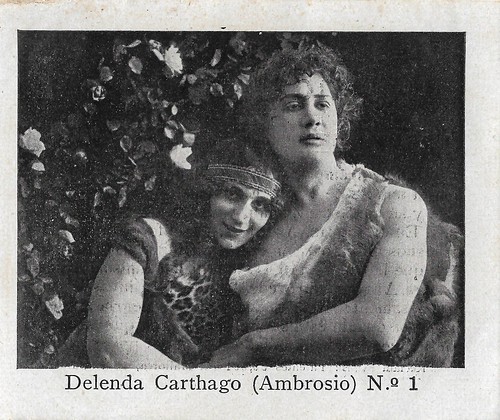
Spanish minicard, no. 1. Photo: Ambrosio. Eugenia Tettono Fior as Miarka and François-Paul Donadio as Shabarim in Delenda Carthago! (Tragedia dell'età antica) (Luigi Maggi, 1914).

Spanish minicard, no. 2. Photo: Ambrosio. Scen from Delenda Carthago! (Tragedia dell'età antica) (Luigi Maggi, 1914).
François-Paul Donadio and Eugenia Tettoni
François-Paul Donadio was an Argentine [?] actor who played in Italian silent cinema between 1914 and 1921. In his first years, Donadio was a regular actor of the troupe at Ambrosio Film, acting in films such as Delenda Carthago! (Tragedia dell'età antica) (Luigi Maggi, 1914), and Romanticismo (Carlo Campogalliani, Arrigo Frusta, 1915) starring Tullio Carminati and Helena Makowska.
In 1916 followed Zvani (Gino Zaccaria 1916) starring Rita Jolivet, Monna Vanna (Mario Caserini, 1916) starring Madeleine Céliat, and Val d'olivi/Valley of the Olive Trees (1916) again starring Carminati and Makowska. In the late 1910s he acted with Helena Makowska in such films as Il principe Zilah (1919), and Folgore (1919) at Gladiator Film.
Donadio made his last films at Rodolfi Film, where he was often directed by Guido Brignone. He co-starred with Lola Visconti Brignone in Fiamma nera (1921), and with Mercedes Brignone in Il quadro di Osvaldo Mars (1921). He also acted in one of Carlo Aldini's earliest films, Ajax (Raimondo Scotti, 1921). All in all, Donadio acted in a little over 30 films.
Eugenia Tettoni (1882-1969) was born in Turin. She started her career at Milano Films, together with her husband, actor Vittorio Tettoni, as Calypso (other sources say Penelope) in L'Odissea (Giuseppe De Liguoro, 1911). She acted in various Milano Film short productions in 1911-1912 and changed to the Ambrosio company in 1913, where she played in features, e.g. as Jone in Gli ultimi giorni di Pompei/The Last Days of Pompei (Eleuterio Rodolfi, 1913), the nun of Monza in I promessi sposi/The Betrothed (Eleuterio Rodolfi, 1913), and Josephine de Beauharnais in Epopea napoleonica (Edoardo Bencivenga, 1914).
Also memorable was her part of the adulterous Elena Loredano in Il fornaretto di Venezia (Luigi Maggi, 1914). Until 1921 Tettoni had a steady but not intense career in Italian silent film, mostly in supporting parts, at companies such as Savoia, Corona, Photo-Drama, Vay, and Audax. From 1922 she only acted on stage, with her by then ex-husband Vittorio Tettoni.

Spanish minicard, no. 3. Photo: Ambrosio. Eugenia Tettono Fior as Miarka and François-Paul Donadio as Shabarim in Delenda Carthago! (Tragedia dell'età antica) (Luigi Maggi, 1914).

Spanish minicard, no. 4. Photo: Ambrosio. Scene from Delenda Carthago! (Tragedia dell'età antica) (Luigi Maggi, 1914).
Some historical and literary elements and much fantasy
The plot of Delenda Carthago!/The Destruction of Carthage (1914) has some historical and literary elements, e.g. Flaubert's 'Salammbô', but also contains much fantasy. In ancient times Rome looked upon Carthage as her greatest rival and determined to plan her downfall. Cato (Umberto Scalpellini), a Roman Senator, appeals to the Senate to conquer Carthage, and under a pretext that she had failed to keep the faith, the Romans begin a new war.
The Roman army led by Scipio (Marcel Fabre) embarks for Africa and lands near Carthage. This ends the prologue. When General Hasdrubal (Luigi Chiesa) sees from the city walls the retreat of the Carthaginian mercenaries led by Hanno (Annone), he conspires to cause the downfall of Hanno. He induces the city council to bar the mercenary troops from the town, fearing disorder and plundering. Messengers are dispatched to the warriors with this command, and they rebel, but Hanno calms them by promising to present their grievances. Hasdrubal denounces Hanno, and upon the latter's appearance in the Senate, he is assassinated.
Miarka (Eugenia Tettoni), daughter of Hasdrubal, is harassed when going to the Temple of Tanit, but Hanno's lieutenant Shabarim (François-Paul Donadio), defends her and escorts her to the city. The impatient warriors start an uproar outside the city, but Hasdrubal calms them, consenting to receive a deputation with their grievances. Shabarim heads the delegation and is received by Hasdrubal, who apparently yields to the soldiers' request. Upon beholding Shabarim, Miarka's stepmother and Hasdrubal's wife Zamah falls in love with him, but he rejects her, after which she condemns him to the galleys. Meanwhile, Scipio conquers Carthage. Hasdrubal deserts his followers and flees to his galleys with his daughter.
Zamah, however, refuses to desert the palace and is killed. death. The Roman fleet pursues Hasdrubal's galleys and defeats them, Hasdrubal being killed in the melee. Miarka discovers Shabarim chained in the ship's hold and succeeds in breaking the chain. He in turn rescues her from the raging flames and, throwing her overboard, jumps after her, leaving the galley to burn to the water's edge. Both lovers succeed in reaching the shore and are reunited once more while witnessing the burning of Carthage in the distance.

Spanish minicard, no. 5. Photo: Ambrosio. Scene from Delenda Carthago! (Tragedia dell'età antica) (Luigi Maggi, 1914).

Spanish minicard, no. 6. Photo: Ambrosio. Eugenia Tettono Fior as Miarka in Delenda Carthago! (Tragedia dell'età antica) (Luigi Maggi, 1914).
Sources: Aldo Bernardini (Cinema muto italiano protagonisti), Vittorio Martinelli (Il cinema muto italiano, 1914, I), The Moving Picture World (via IMDb), and IMDb. NB. The Moving Picture World makes a hodgepodge of the Italian names of the characters.
No comments:
Post a Comment